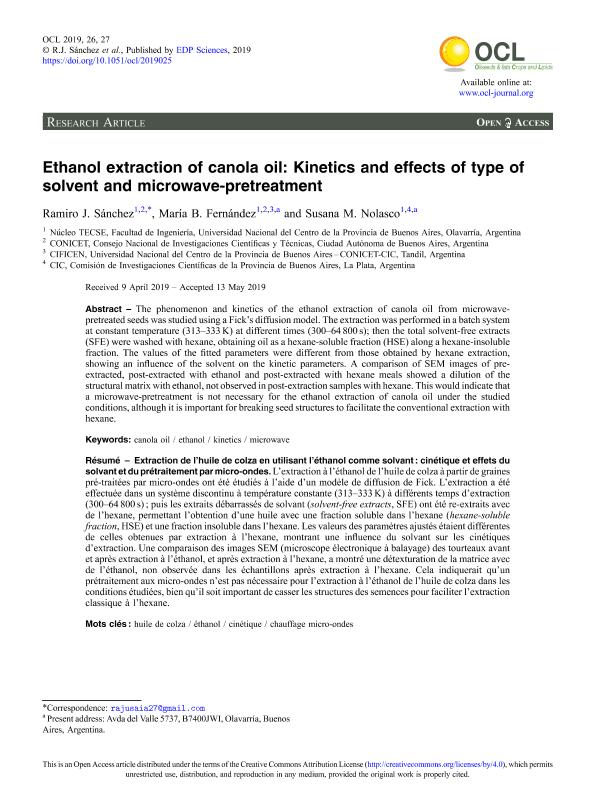Artículo
The phenomenon and kinetics of the ethanol extraction of canola oil from microwavepretreated seeds was studied using a Fick’s diffusion model. The extraction was performed in a batch system at constant temperature (313–333 K) at different times (300–64 800 s); then the total solvent-free extracts (SFE) were washed with hexane, obtaining oil as a hexane-soluble fraction (HSE) along a hexane-insoluble fraction. The values of the fitted parameters were different from those obtained by hexane extraction, showing an influence of the solvent on the kinetic parameters. A comparison of SEM images of preextracted, post-extracted with ethanol and post-extracted with hexane meals showed a dilution of the structural matrix with ethanol, not observed in post-extraction samples with hexane. This would indicate that a microwave-pretreatment is not necessary for the ethanol extraction of canola oil under the studied conditions, although it is important for breaking seed structures to facilitate the conventional extraction with hexane. L’extraction à l’éthanol de l’huile de colza à partir de graines pré-traitées par micro-ondes ont été étudiés à l’aide d’un modèle de diffusion de Fick. L’extraction a été effectuée dans un système discontinu à température constante (313–333 K) à différents temps d’extraction (300–64 800 s) ; puis les extraits débarrassés de solvant (solvent-free extracts, SFE) ont été re-extraits avec de l’hexane, permettant l’obtention d’une huile avec une fraction soluble dans l’hexane (hexane-soluble fraction, HSE) et une fraction insoluble dans l’hexane. Les valeurs des paramètres ajustés étaient différentes de celles obtenues par extraction à l’hexane, montrant une influence du solvant sur les cinétiques d’extraction. Une comparaison des images SEM (microscope électronique à balayage) des tourteaux avant et après extraction à l’éthanol, et après extraction à l’hexane, a montré une détexturation de la matrice avec de l’éthanol, non observée dans les échantillons après extraction à l’hexane. Cela indiquerait qu’un prétraitement aux micro-ondes n’est pas nécessaire pour l’extraction à l’éthanol de l’huile de colza dans les conditions étudiées, bien qu’il soit important de casser les structures des semences pour faciliter l’extraction classique à l’hexane.
Ethanol extraction of canola oil: Kinetics and effects of type of solvent and microwave-pretreatment
Título:
Extraction de l’huile de colza en utilisant l’éthanol comme solvant : cinétique et effets du solvant et du prétraitement par micro-ondes
Fecha de publicación:
05/2019
Editorial:
EDP Sciences
Revista:
Oilseeds and fats, Crops and Lipids
ISSN:
2272-6977
Idioma:
Inglés
Tipo de recurso:
Artículo publicado
Clasificación temática:
Resumen
Palabras clave:
CANOLA OIL
,
ETHANOL
,
KINETICS
,
MICROWAVE
Archivos asociados
Licencia
Identificadores
Colecciones
Articulos(CCT - TANDIL)
Articulos de CTRO CIENTIFICO TECNOLOGICO CONICET - TANDIL
Articulos de CTRO CIENTIFICO TECNOLOGICO CONICET - TANDIL
Citación
Sánchez, Ramiro Julián; Fernández, María Belén; Nolasco, Susana Maria; Ethanol extraction of canola oil: Kinetics and effects of type of solvent and microwave-pretreatment; EDP Sciences; Oilseeds and fats, Crops and Lipids; 26; 5-2019; 1-7
Compartir
Altmétricas




